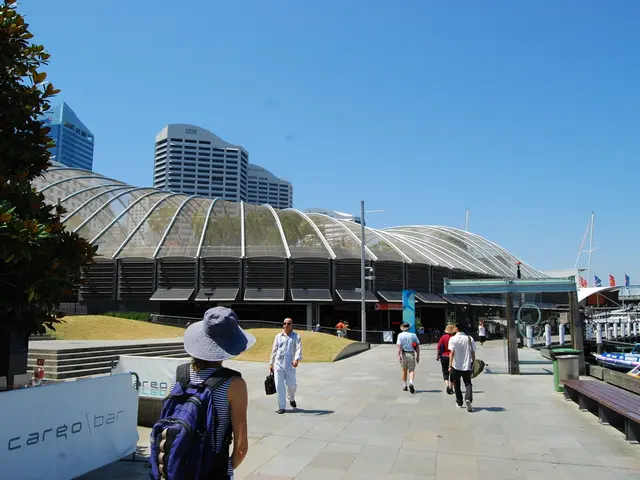Mobile Eye Care Revolution: Tackling Eye Doctor Deficit in Southwest Saxony
Mobile Eye Examination Services Due to Doctor Shortage - Insufficient Medical Professionals: Mobile Clinics Struggle with Eye Exams
- Let's dive in!
A revolutionary mobile eye care practice is poised to solve the mounting issue of scarce appointments and long wait times in the heartland of Southwest Saxony. The pioneering project, nicknamed MUBE - Mobile Eye Examination and Treatment Unit, aims to cater to patients requiring regular routine check-ups, according to the Association of Statutory Health Insurance Physicians during a recent presentation in the scenic Vogtland region. The project boasts a whopping 90% funding from the Ministry of Social Affairs, amounting to 1.2 million euros.
The medical landscape for ophthalmologists in the region has reportedly been crumbling over the past few years, with many doctors shuttering their practices due to advancing age. Simultaneously, demand is soaring due to the growing senior population. Social Affairs Minister Petra Köpping (SPD) acknowledges, "Providing healthcare remains a formidable challenge." MUBE represents a major stride in attending to patients in underserved rural areas.
Here's the lowdown on how things operate in the mobile practice:
Initially, patients undergo an examination by an ophthalmologist in their local area. Those devoid of an ophthalmologist are directed to make an appointment with one of the project's collaborators for the preliminary diagnostic phase. Follow-up examinations are thereafter conducted by trained, non-medical staff in the mobile practice. All results are digitally transmitted to an ophthalmologist. If necessary, an ophthalmologist can be linked via video conferencing to deliberate further treatment procedures. In the event of any significant findings, the practice staff will steer patients to a doctor for subsequent treatment.
The mobile practice's service offerings include standard check-ups for various eye health conditions, such as age-related macular degeneration, glaucoma, cataracts, and diabetic retinopathy. The mobile clinic will make scheduled stops in Auerbach, Schwarzenberg, and Markneukirchen. Statutory health insurers will absorb the costs of these examinations.
Rural health care accessibility, particularly for ophthalmologists, is dwindling, as per the Association of Statutory Health Insurance Physicians in Saxony (KVS). A decreasing number of doctors are opting to establish practices outside major cities. Furthermore, escalating medical demands stemming from an aging population are putting strain on existing practices, leading to longer journeys and wait times for patients. The KVS notes that no conclusive data exists on the evolution of wait times.
Detailed Insights into MUBE and Appointment Requests
- Southwest Saxony
- Telemedicine
- The Vogtland Region
- Statutory Health Insurance Physicians
- Petra Köpping
- Healthcare Demand
- Doctor Shortages
- Wait Times
- Mobile Eye Care
- And here's the scoop on MUBE!
To offer a comprehensive overview of MUBE's impact on tackling doctor shortages and reducing wait times for eye care services in Southwest Saxony, it's crucial to evaluate several important factors. Here's a structured perspective on assessing its effectiveness:
1. MUBE Mobile Eye Care Practice Insights
- Background: MUBE is likely a mobile health service designed to deliver eye care directly to patients, especially in areas with minimal specialist resources. This model is vital in regions where healthcare access is limited, like Southwest Saxony.
- Purpose: The primary objective is to improve geographical equity in healthcare access, particularly in areas with a paucity of ophthalmologists.
2. Addressing Doctor Shortages
- Accessibility: By offering mobile eye care services, MUBE can reach remote or underserved regions, providing eye care where traditional facilities may not be easily accessible. This results in a more equitable distribution of healthcare resources across the area.
- Collaborations: Strategic partnerships with local healthcare providers can amplify the reach and efficiency of the service, potentially improving the doctor-to-patient ratio in underserved regions.
3. Reducing Wait Times
- Efficiency: By delivering services directly to the community, MUBE can diminish the requirement for extensive travel to distant healthcare facilities, thereby cutting down on wait times for initial consultations and follow-ups.
- Preventive Care: Early detection and treatment afforded by mobile services can prevent severe eye conditions from developing, which may otherwise necessitate more time-consuming treatments.
4. Community Impact
- Patient Satisfaction: Feedback from patients can shed light on whether the service caters to their needs and expectations effectively. Positive feedback typically coincides with increased accessibility and reduced wait times.
- Health Outcomes: Noteworthy improvements in health outcomes, such as better visual clarity and early detection of eye diseases, can demonstrate the effectiveness of the practice.
5. Challenges and Future Prospects
- Sustainability: For the long-term viability of mobile eye care practices, ongoing funding and resource management are vital. Community participation and partnerships with local healthcare systems can keep these services alive.
- Technology Integration: Harnessing cutting-edge diagnostic tools and telemedicine technologies can further enhance the efficiency and outreach of the service.
- The Community policy in Southwest Saxony could be updated to include the integration of vocational training programs for non-medical staff, enabling them to effectively operate the Mobile Eye Examination and Treatment Unit (MUBE) and contribute to the field of eye health.
- In light of the significant investment in the MUBE project, collaborative research with scientific institutions could be pursued to assess the impact of mobile eye care on medical-conditions such as age-related macular degeneration, glaucoma, cataracts, and diabetic retinness, as well as health-and-wellness general outcomes of patients in the Vogtland region.




